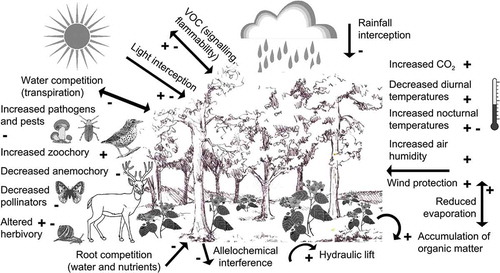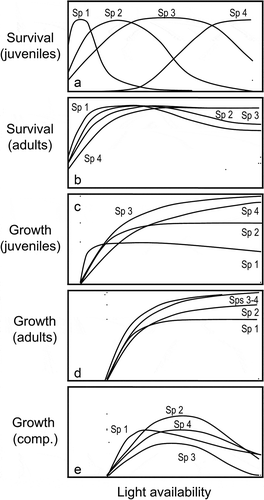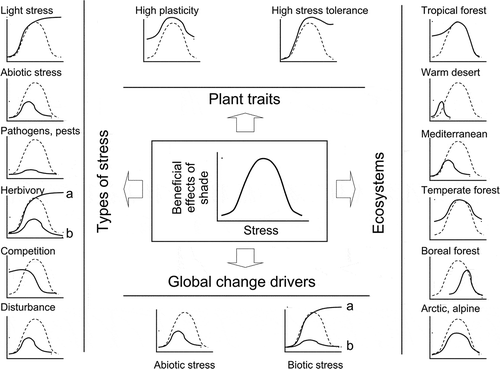Figures & data
Table 1. What we know about shade and shade tolerance, and what we do not know yet.
Figure 1. Understorey plant life involves coping with a wide range of environmental changes. While some environmental conditions are clearly beneficial for understorey plants (e.g. increased organic matter in the soil, wind protection, increased seed dispersal by animals) others are disadvantageous (e.g. root competition for water and nutrients, increased phytophagous fungi and pests, decreased number of pollinators) as indicated in the figure by plus and minus symbols, respectively. At least four environmental factors can have either negative or positive effect on recruitment of plant individuals: reduced irradiance (positive under photoinhibitory conditions, negative when light interception by the canopy severely limits understorey photosynthesis), herbivory (positive when the canopy acts as a barrier for herbivores, negative when more herbivores are found in the shade), volatile organic compounds (VOCs, positive when attracting pests’ enemies, negative when increasing flammability), and increased nocturnal temperatures (positive when cold snaps are attenuated, negative when respiration and thus carbon loss is enhanced).

Figure 2. Idealised survival (a–b) and growth (c–e) responses to light availability in four species of contrasting shade tolerances. While species 1 is a typical shade tolerator, species 4 does not tolerate shade, and the other two species represent various intermediate cases. Different responses are observed in juveniles (a and c) and adults (b and d–e) of the very same species, with adults exhibiting less pronounced interspecific differences in their responses to light than juveniles. Competition (e; when growth response is analysed in multi-specific scenarios) affects non-linearly the response to light, tending to decrease growth for a given light availability.

Figure 3. Understorey life (shade sensu lato) can be advantageous for plants when compared to life in the open. We suggest that how these beneficial effects of shade vary with stress can be represented by a Gaussian bell, with an intermediate range of stress intensity for which understorey life is clearly advantageous. In general, the advantages of living in the shade would be reduced at either low or high levels of stress because environmental conditions cannot be ameliorated by a canopy at the ends of the stress gradient, either because there is no condition to be enhanced with respect to the open when stress is low or because stress is exacerbated by limiting light when the former is very intense. But, the net balance of advantages and disadvantages, and thus the shape of this beneficial effect of the shade vs. stress intensity curve, varies depending on the type of stress, the traits of the target plant and the overall conditions of the ecosystem (compare continuous lines with dashed lines representing the general model in each graph). While phenotypic plasticity and stress tolerance of the target plant tend to increase the potential benefits of living in the shade, most stresses tend to decrease them. However, high light stress makes the shade increasingly beneficial at increasing stress till benefits reach a species-specific plateau, and competition-induced stress makes the shade beneficial only at low levels of stress. Shade becomes relatively more beneficial at low levels of stress in dry and hot ecosystems, but more beneficial at high levels of stress in boreal forests due to the nature of the predominant stress in each ecosystem, i.e. drought vs. freezing temperatures respectively. Stresses induced by the many drivers of global change also affect the beneficial effects of the shade vs. stress intensity curve. Shade can be increasingly beneficial with increasing herbivory if the canopy is effective in keeping away the herbivores (a, central graph at the left hand side column of graphs) or it can be disadvantageous if herbivores are more active or in greater number in the shade (b). Analogously, the stress induced by invasive species can make the shade increasingly beneficial if invasive species prefer high light habitats (a, graph at the right in the lower row of graphs) or it can make it disadvantageous over most of the stress range if invasive species prefer understorey habitats (b).

